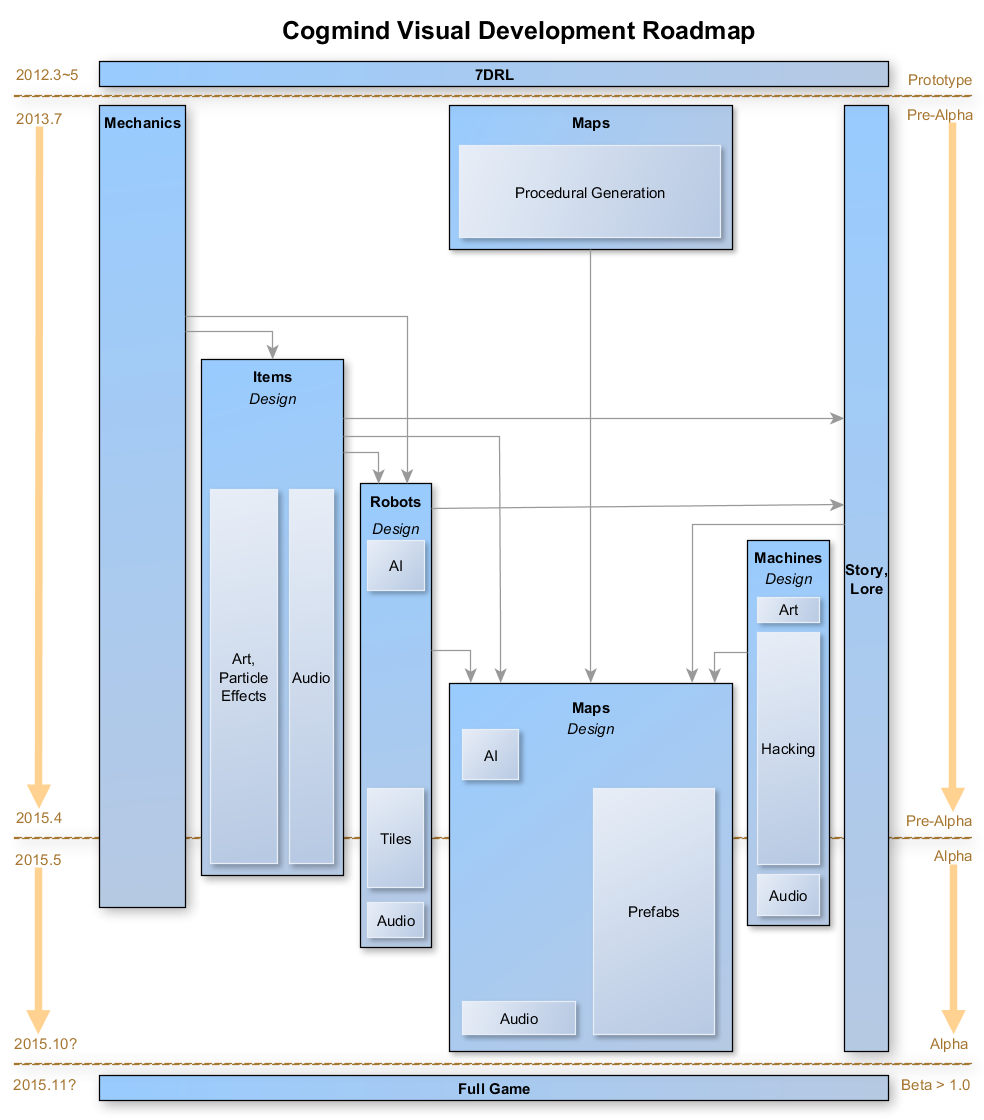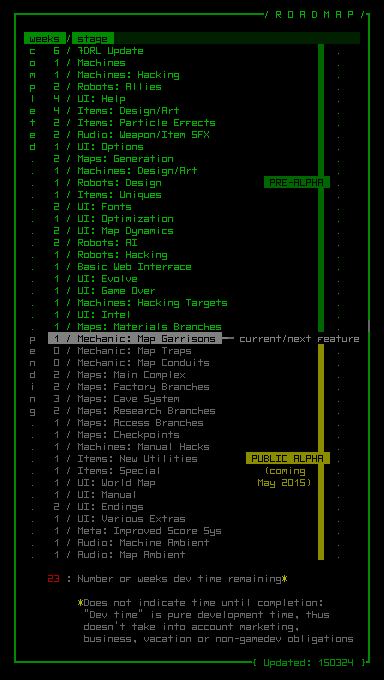Cogmind’s first public alpha release, scheduled for May as announced earlier, will be both playable and fun, but by no means done. This post explains what will and will not be included in the first release, and where development will go from there.
What is ready?
First and most importantly, what exactly can you already do in the game?
Simply put, Cogmind is functionally complete. I wouldn’t want to launch anything that doesn’t already offer an enjoyable experience. Thus we have the entire core game and its wide array of mechanics:
- Build and modify a unique robot from parts salvaged from scrapheaps and fallen enemies.
- Dozens of meaningful stats you can pore over (or mostly ignore if you don’t care about the details).
- Engage in direct combat (mostly ranged, but melee is an option) or choose to take advantage of a very viable stealth system to evade most threats.
- Hack robots and machines for intel and other purposes.
- Fully procedurally generated maps, fully destructible :)
Even once you know the mechanics inside and out, procedural maps combined with plenty of unique content mean the game already contains a huge amount of replayability. Content-wise there is currently plenty to discover and experience:
- Many completely unique robot classes to interact with, or even control (though allies will not be as plentiful or easy to come by in the initial release as they will be in subsequent versions).
- Many hundreds of unique items, each with their own ASCII art.
- Explore 10 depths to the end game (the largest maps cover 20,000~30,000 spaces).
- Start learning about the world’s story and lore via hacking.
- A zillion sound effects (or somewhere around that number) for weapons, destruction, and more.
- An equally zillion ASCII particle effects with the potential to blow minds (effect tripled when combined with sound effects).
- The most powerful ASCII UI in history (simply too much to link here--so many more features…).
- Both fully operational ASCII and tiles modes.
If you’ve played the prototype from 2012, and many of you did and had great things to say, it’s like that only x100.
And by the time we’re done it’s going to be x200, or so :)
What are we missing?
While it’s likely we’ll be adding a few new mechanics later on, that part of the game already offers a complete experience. What we’re missing from the must-have category of features is a rather large chunk of the world and related content that guides the overall experience.
Essentially we have a lot of core content as described above, but need to add much of the complementary content that makes up the world, as well as a few features that glue it all together. That’s an abstract way of explaining that we’re missing:
- Different Maps: While you can currently traverse the main complex straight to the end of the game, the intention is that you’ll sometimes want to take a few detours into other areas for various purposes. As is, beginning in the mid/late-game areas you’ll find a fair number of blocked exits because many of these branches are incomplete and therefore closed off. There are about 7 map styles out of a planned 25-30. For the final stretch of pre-alpha development, just completed, we did add initial versions of the two primary early-game branches.
- Map Content: Aside from their robot inhabitants, and machines, maps lack additional unique character that will later be provided by encounters and more hand-made content. There is still plenty to enjoy, however. It’s not that you’ll be bored, but more that the game is missing a fair bit of “extra stuff.”
- Story: The interactive parts of the story have not been added, as almost all of it takes place outside the main complex in branches that aren’t prepared. For now you’ll be able to read background information scattered throughout the complex, and thereby learn about the story indirectly.
- NPCs: The only unique NPC you’ll see is Revision 17, who briefly greets you as part of the introduction. Other NPCs will be gradually added as their respective maps become accessible. Some of the new branches already contain non-unique NPC encounters, mostly as a demonstration of things to come.
- Ambient sound, both emitted from machines and the environment in general. I’ll include a placeholder door sound effect because hearing those is rather important, as well as a couple machine sounds just to demonstrate how they work.
As you can see, most everything “missing” can be considered fluff as far as traditional roguelikes are concerned. There is already a fun and mechanically deep game to play, but it will grow to be an increasingly compelling experience as development continues towards 1.0.
Another point worth making is that balance will be rough at first. This is intentional, because planned content will be used to counterbalance some of what is already there. Currently, unless you really know what you’re doing, you stand a good chance of getting roflstomped around the half-way mark (I still want to do a bit more balancing before release, so it’s possible it’ll get a little easier, but my goal here is not to make an easy roguelike--if there even is such a thing).
Alpha and Beyond
The purpose of releasing the alpha version in its current state, shortly after the conclusion of what I consider pre-alpha development, is to demonstrate the game’s solid foundation and make any necessary adjustments before building an entire world on top of it.
That latter stage will be relatively quick since all the building blocks are in place, but we may want to tweak some of those building blocks beforehand, and large scale feedback has the greatest chance of suggesting meaningful changes. And not just subjective player opinions, either--a wide array of optional metrics will let me know how players are interacting with the game and help guide development in the intended direction. This is something I can’t do myself or with just a handful of playtesters.
The remaining path towards 1.0 is 90% decided by the design doc, but the other 10% is fairly flexible, with additional features beyond the full release also possible.
See the diagram below for a visualization of the game’s current state and future direction:

Cogmind Visual Development Roadmap (click for full size). Update 150615: Due to Cogmind’s unexpectedly strong alpha launch in May, an expanded budget and feature set mean that the full game is more likely to be completed by mid-2016 rather than the end of 2015.
As you can see, the vast majority of work to do is world building, which aside from a few little things here and there is mostly about adding maps and whatever other unfinished content they might need. For a more specific breakdown of features to come, see the new roadmap maintained on the website FAQ:
It’s difficult to predict the long-term time frame with any certainty, because much will depend on how the game is received. There is a minimal “I must do all these things for Cogmind to be what it should” list, and a separate “if Cogmind is popular enough I’ll be happy to run with it and add more” list. The final game probably lies somewhere in the middle, but I can’t be sure which of those features will be added and when, so the indicated times are only rough estimates.
One thing is certain: During the alpha-beta period updates will come frequently. With all the game’s internal moving parts in place, creating the rest of the experience will be a smooth process.



6 Comments
This may be a silly question, but what kind of system requirements do you have so far? Specifically, will it run comfortably on a 10 years old laptop?
Also, what is going to be the harddrive footprint?
Very legitimate question, and something I’ve never brought up before (not officially, anyway). The good news is the requirements are pretty light. There are no video card or driver requirements at all--Cogmind is a CPU-heavy game, so that one factor determines the entire performance.
Ten years might be pushing it, especially on later floors where there is a lot going on. I can at least say that following the prototype the engine was tweaked such that slower machines will no longer experience graphical artifacts like they would before. Also, unlike other games that might be built using powerful “dev rigs,” Cogmind is currently developed on my three-year-old laptop (~2.0Ghz), on which it runs quite fast--over 200 FPS even on later more crowded floors.
Thanks for asking, because one thing I should do before launch is run the game under a CPU limiter to simulate how well it runs on really old CPUs and publish the minimum requirement.
The first alpha will probably weigh in at about 15 MB, of which a majority is the sound assets. Further in the future we’ll be adding even more audio elements but can’t yet estimate what that will push the total size up to. It would likely remain reasonably within 50-75 MB (the additional assets could be made optional).
This is a decidedly unsilly question: what is the distinction between the “main complex” and other areas? I thought Cogmind took place in one complex and the goal was to more or less hustle to the elevator on each level.
Unsilly question, but still funny you ask because I’m actually writing a long answer to it right now in the form of an entire blog post about the world’s composition :).
You’ll have to wait two blog posts from now for the full answer (with diagrams!). For now I’ll say that in order to give the game more optional content without unnecessarily making it longer, I widened the world by adding branches akin to what you have in DCSS. You can explore these areas, and may want to for certain reasons, but you don’t have to. In all, the world is much larger than before, with even the main complex maps growing significantly in size as seen in this old shot.
Will we be able to buy the source code, or just binaries?
Sorry, it’s binaries only. Closed source.